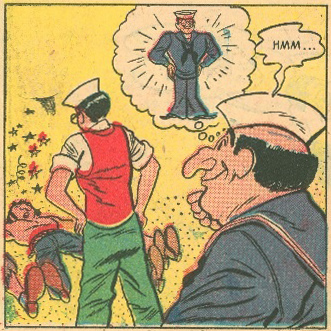The Navy comic Li’l Abner Joins the Navy!, starring the well-known Al Capp character Li’l Abner, emphasizes restraint and focused aggression in the face of adversity. Li’l Abner, though simple-minded and a bit naive, nearly always represented the moral high ground, and was often contrasted against others will unscrupulous intentions. His morality, along with his impressive stature and chiseled good looks, made him a fitting representative of restraint and appropriate aggression in the face of adversity.
The story begins when Drawin’-Board McEasel interviews for a job as an artist with Al Capp, but is turned down. Drawin’ Board is hardly a masculine specimen; an intellectual (in contrast to other Dogpatch residents) with a small stature, oversized bow tie, and glasses. When a mutual friend introduced him to Al Capp, he was introduced with the caveat, “He’s not much to look at, but…”[^] Months pass, and Li’l Abner receives a letter from Drawin’-Board, who wanted to explain what happened to him after the interview in Dogpatch.[^] He had returned on Sadie Hawkins Day, and he, like all of the men in town, was running away from a horde of women.[^] Drawin’-Board witnesses a Navy recruiter coming to Dogpatch to sign up “…lots o’ strong-backed, intelligent young men…eager to serve their country in her first line of defense.”[^] The recruit gives his recruiting pitch, but is overrun first by the fleeing men and then by the women n pursuit, and is left unconscious on the ground.[^] The recruiter and Drawin’-Board then encounter another group of people leaving, this time proclaiming, “Run fo’ yo’ lives!! Th’ Screwballs is on th’ loose agin!!!”[^]
The Screwballs, a band of burly, savage criminals, know that all the able-bodied men would be chased by the women on Sadie Hawkins Day, so they moved in to steal everything from the old men and women who remained in town.[^] Upon seeing The Screwballs, the recruiter deputizes Drawin’-Board into the Navy and then proclaims, “The Navy always carries the fight to the enemy! We prefer to fight in his backyard, not ours!!”[^]
They also do so by turning the tables and taking the fight to the Screwballs’ “backyard.”[^] They even go so far as exclaiming “Remember Pearl Harbor!” when they attack the screwballs, recalling the triumph of the US when the nation was first attacked, and then turned the aggression to the Japanese and retaliated on their own home turf.[^] The two much smaller men dispatch with the burly Screwballs with no problem, leaving them laying on the ground, dazed and bruised, saying “Th’ yewnited states navy shore packs a wallop (groan!)” and “Ow! (sob!) must be a torpedo bashed may jaw!…” giving credit to the Navy for the recruiter and Drawin’-Board’s ability to fight them off.[^]
Following their defeat, the Screwballs join with two new associates and attempt to steal plans for a new Navy vehicle. The recruiter recognizes them, and with the help of Drawin’-Board and a white haired sailor named Salty McAnchor, the three catch and subdue the would-be traitors, despite the physical and numerical disadvantage.[^] Their status as sailors is seemingly the only advantage they have, but it is enough to physically overpower them again.
After demonstrating this use of aggression to protect those weaker than him, the restraint concept was extrapolated to national diplomacy. The publication informs readers that, “The Navy is our best insurance to discourage a country from picking a fight with us…and if war does come, a strong Navy keeps destruction from our shores by carrying the battle to the enemy in his backyard!”[^] This echoes conceptions about middle class white masculinity, which prided themselves on restraint every bit as much as on paternalistic protection and aggressive capabilities. By standing strong and putting forth an aggressive and intimidating front, challenges, both interpersonal and international, could be diffused, and security could be attained without violence.
Li’l Abner Joins the Navy! also emphasized the ability of Navy men to fight and protect others, especially those seen as weaker or more innocent. The recruiter draws upon and reinforces the masculine conception of protection over the feminine by referring to the United States as a feminized “her” and the aggressor nations as “him.”[^] Even though the Navy recruiter and Drawin’-Board are not depicted as overly masculine, Drawin’-Board is deputized into the Navy, and the two enlisted men take on the three larger criminals.[^] The recruiter also imagines Drawin’-Board as a sailor, and the image in his mind is a much stronger, barrel-chested version, representing the transformation often represented in recruiting materials.[^]
Related Sections
- Adventurousness & Aggressiveness
- Adventurousness & Aggressiveness - A'feudin' and A'fightin'
- Adventurousness & Aggressiveness - Defend Your Country
- Adventurousness & Aggressiveness - Flight Into Fury
- Adventurousness & Aggressiveness - Palau
- Adventurousness & Aggressiveness - Pvt. Droop Has Missed the War!
- Adventurousness & Aggressiveness - Saipan
- Adventurousness & Aggressiveness - Tarawa
- Adventurousness & Aggressiveness - The Fighting Redhead
- Adventurousness & Aggressiveness - Vanguard of Doom
Primary Sources




